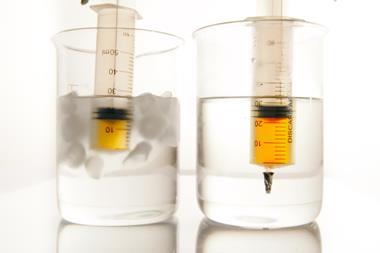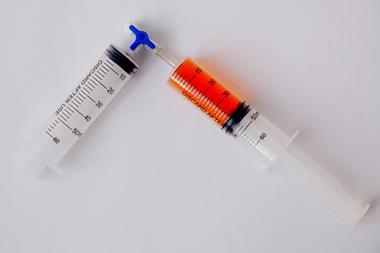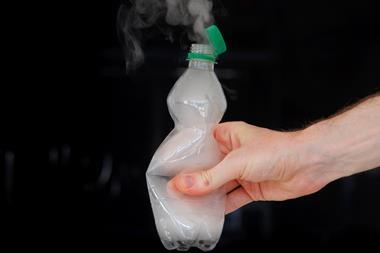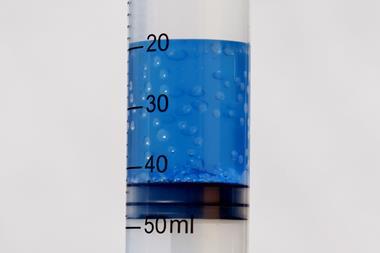[Add video symbol] Watch the video and download technicians notes: rsc.li/EiC217ec
Calcium carbide and the ethyne gas it produces on contact with water are a rich source of exciting demonstrations. In previous columns we have explored ethyne’s unsaturation1 and used it to propel food cans into the air,2 but in this issue we produce a contact explosive capable of producing some impressive bangs.
Calcium carbide and the ethyne gas it produces on contact with water are a rich source of exciting demonstrations. In previous columns we have explored ethyne’s unsaturation and used it to propel food cans into the air, but in this issue we produce a contact explosive capable of producing some impressive bangs.
Kit
- Calcium carbide, c.1 g (highly flammable)
- Silver nitrate solution, 0.25 mol dm-3, 15 cm3 (irritant)
- Sodium hydroxide solution, 1 mol dm-3, c.5 cm3 (corrosive)
- Ammonium hydroxide solution, 2 mol dm-3, c.5 cm3 (corrosive, irritant)
- Copper(II) sulfate solution, 0.1 mol dm-3, c.20 cm3
- 2 side-arm boiling tubes with delivery tubes
- Bungs
- 1 boiling tube
- Filter paper and funnel
- Bunsen burner, heat-resistant mat, tripod and gauze
- Boiling tube rack
- Optional large sheet of hardboard for protecting the bench
Preparation
Wear eye protection. Prepare ammoniacal silver nitrate in a boiling tube by adding sodium hydroxide solution (1 mol dm-3) dropwise to 15 cm3 of 0.25 mol dm-3 silver nitrate until a precipitate of silver oxide forms. Add ammonia solution (2 mol dm-3) dropwise, stirring thoroughly until the precipitate re-dissolves to form a colourless solution.
Set up a chain of boiling tubes and delivery tubes in a boiling tube rack. The first side-arm boiling tube should contain approx. 15–20 cm3 of water (leaving a gap to the side-arm so liquid will not bubble over once the calcium carbide is added). The delivery tube from the side-arm of the first tube should be set up to bubble gas through the copper sulfate solution in the second tube to absorb hydrogen sulfide gas. The purified acetylene gas then bubbles through the ammoniacal silver nitrate prepared in the previous step. Cutting the teat off a plastic dropping pipette and inserting into the end of the rubber tubing can help keep the tube out of the liquid and deliver a controlled flow of bubbles to the bottom of the liquid.
In front of the class
Do the demonstration at the start of the class to leave time for cleaning up. Add the calcium carbide chips to the water in the first tube and replace the bung – acetylene gas will bubble through the final tube generating a precipitate of silver acetylide. Wear a face shield when working with the precipitate. Filter the solution and while still damp, transfer the residue to a gauze on a tripod placed behind two safety screens – one for the audience and one for the demonstrator. Students should sit well back, wear eye protection, and be warned about a loud bang. Place a lit Bunsen under the gauze and retreat to a safe distance. As the precipitate dries, the explosive detonates with a number of bangs, each accompanied by a small flash and a tiny puff of soot.
Tips
Setting up the demonstration on a large sheet of hardboard can protect the bench and make burning up unreacted powder with a flame a lot easier. A cylinder of wire mesh (such as insect mesh) can be placed around the precipitate before heating – this will contain most powder fragments and make cleaning up much quicker.
Teaching goal
Marcellin Berthelot first synthesised silver acetylide in 1866. It was one of a range of compounds he made from inorganic sources. These collectively provided evidence to refute Berzelius’s theory that organic compounds must be produced by living organisms – hence the name given to this branch of chemistry. The formation of a precipitate from ammoniacal silver nitrate was used as a test for the presence of terminal alkynyl groups until the mid-20th century.
Silver acetylide contains an unexpected type of bond between the silver and the carbon atom, and students who can use a Van Arkel–Ketelaar bonding triangle may be surprised by the predicted levels of covalency in the Ag–C bond. Parallels can obviously also be drawn for students who have studied transition metal complexes – some courses require students to be able to recall the structure of the diamminesilver ion present in the solution from which the explosive was precipitated.
Pure silver acetylide is an unusual explosive because in principle it produces no gas when it explodes (see the equation below), although in practice small amounts of hydrogen, nitrogen and carbon dioxide are usually evolved due to the presence of impurities.
Ag2C2 (s) → 2Ag(s) + 2C(s) ΔH = –357.6 ± 5.0 kJ mol-1
Reaction with silver nitrate directly produces double salts such as AgC2.AgNO3 that produce significantly louder bangs due to the large increase in the volume of gaseous products. This is reflected in the detonation velocities of the two compounds: 1200 m s-1 and 1980 m s-1 for the simple and double salt respectively. Such double salts, which tend to be less impact sensitive, are sometimes used as primary detonators.
Safety and disposal
This demonstration is unlikely to be covered by your school’s model risk assessments and a special risk assessment may be required. CLEAPSS members can obtain one by contacting them. This procedure is designed to ensure that no more than 0.5 g of explosive is produced to comply with the UK Explosives Regulations 2014 – producing larger amounts should not be attempted and is illegal in the UK without an explosives certificate issued by the police.
Calcium carbide will burn the skin and is harmful if swallowed or inhaled. Solid CaC2 reacts with moisture in the air to produce gas, so pressure may build up in sealed containers containing the solid. Open containers with care. Ethyne forms explosive mixtures with air.
Do not add the calcium carbide to the silver nitrate solution directly or bubble the gas directly through silver nitrate solution – explosive double salts will be produced.
Following the demonstration, unreacted solid can be disposed of by passing a Bunsen flame over the surrounding area. This should be repeated the following morning as small fragments of damp powder can be thrown out by larger detonations, dry overnight to become contact sensitive, and startle other lab users.
Downloads
Technicians notes
Word, Size 53.2 kbTechnicians notes
PDF, Size 50.15 kb















1 Reader's comment